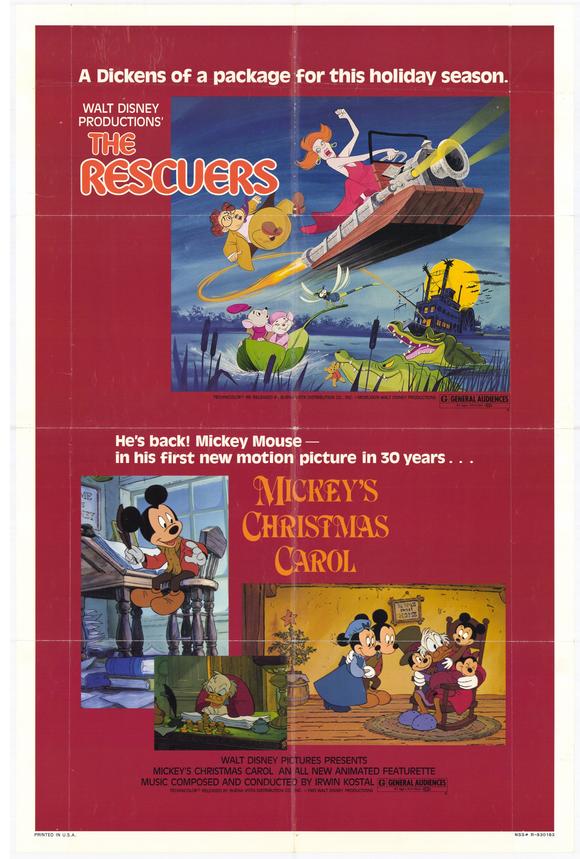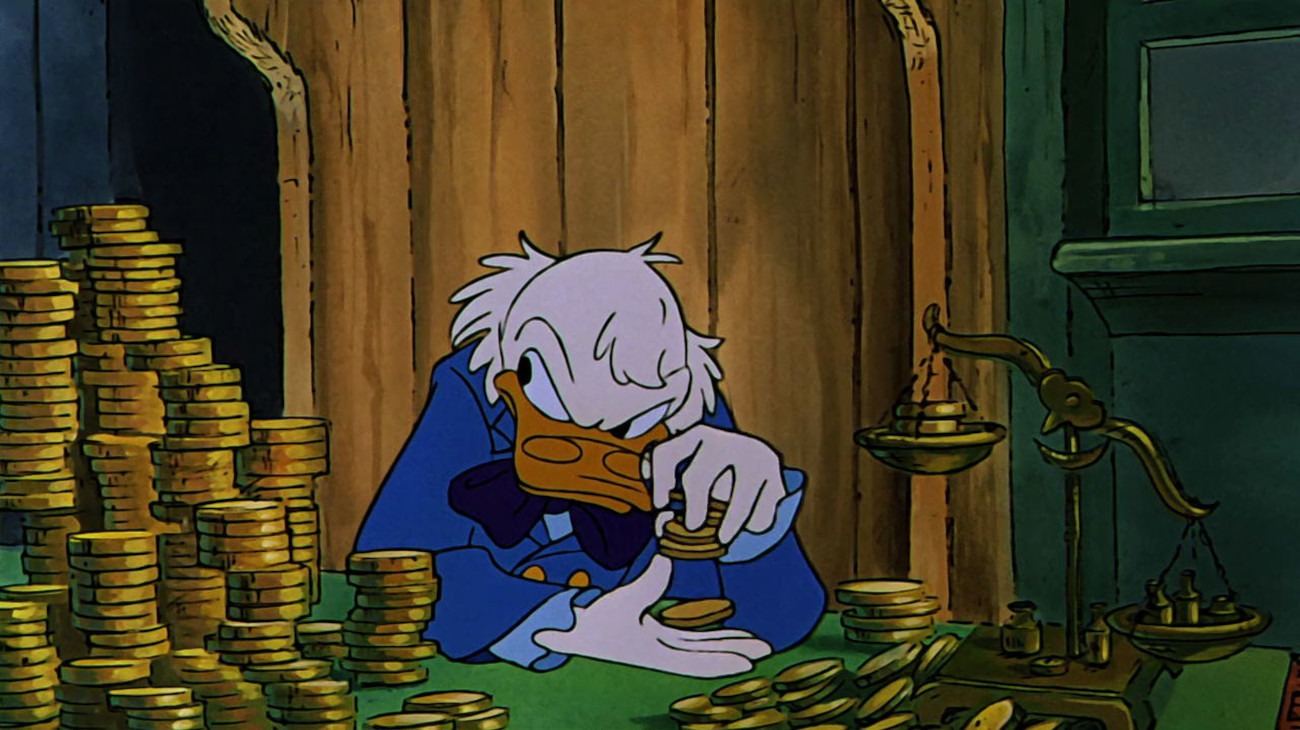
Christmas Carols: The cartoon
Dedicated to the memory of Roy Edward Disney, 1930-2009.
Thank you for all that you did for your uncle's company, and how grateful I am that you lived to see the rebirth of traditional Disney animation.
That there are a great many feature-length cinematic versions of A Christmas Carol is entirely true (and who can say how many theatrical stagings there have been?), but the total number of adaptations is somewhat exaggerated when we take note of cartoon shorts and animated TV specials based on the work, plus episodes of various cartoon series; the basic nugget of Dickens's narrative has proved to be like catnip for short-form animation producers, apparently. There are two basic models in adapting the story for pre-existing cartoon ensembles: the one in which familiar cartoon characters are "cast" in the roles of Ebenezer Scrooge, the Spirits, Bob Cratchit, and the rest, or (and this is rather the tendency of the "episode of a series" adaptations) a regular character is subjected to a Christmas Carol-like adventure, being confronted by the past, present, and future to amend his or her ways.
Not the earliest of the short cartoon adaptations (I believe that to be Mister Magoo's Christmas Carol of 1962), but almost without a shadow of a doubt the most famous is the 1983 Disney short Mickey's Christmas Carol, based on a 1972 audio recording in which several famous Disney characters (or rather, their voices - or rather, vocal mimics of long-dead or long-retired voice actors) played all the parts of Dickens's story. The film version of the project was conceived in the early 1980s to restore some of the luster to Mickey Mouse's long-stalled career - he had not appeared in a theatrical cartoon since 1953's The Simple Things - and as I suspect (though this is nowhere officially mentioned in Disney's self-edited history), to give the animators something to occupy themselves during the miserable production of The Black Cauldron, ultimately released in 1985. The film was shown in front of the first re-release of The Rescuers (ironically, the next Mickey cartoon, The Prince and the Pauper, was shown in front of The Rescuers Down Under in 1990), though it wasn't merely a value-added bonus, but a well-advertised and even somewhat prestigious half of a double feature.
As a Mickey Mouse cartoon, Mickey's Christmas Carol is something of an abject failure: Mickey (Wayne Allwine) is barely in this highly truncated version of the story, playing Bob Cratchit; Ebenezer Scrooge is rather naturally played by Scrooge McDuck (Alan Young, Disney's definitive Scrooge, playing the role for the first time in a filmed project). To be perfectly honest, as an adaptation of A Christmas Carol, this isn't particularly great shakes either, though it is certainly no worse than any other 24-minute version of the story; at that length the best one can hope for is that all of the most necessary of the story beats will be addressed clearly enough that you never get lost, and this much the squadron of writers led by director Burny Mattinson were able to achieve with great aplomb. It might indeed be the nicest thing I can say about the film that even with its massive number of cuts, I can't imagine how they managed to fit everything into such a little bit of time.
But, the true Christmas Carol fanatic is going to miss quite a few things here: Scrooge's outrageously misanthropic huff that if the poor are going to die, "they had better do it, and decrease the surplus population" (why that didn't fit into a Disney cartoon, I can't guess), the scene of his humiliation at Fred's party, witnessed as an unseen ghost (incidentally, Fred is Donald Duck, voiced for the last time in this project by Clarence Nash); and the matter of his courtship and subsequent abandonment of Belle (Daisy Duck, voiced by Patricia Parris) is truncated to such a small number of scenes that it has not a trace of the same impact in any decent feature version of the story. That's really the biggest problem with Mickey's Christmas Carol, or any other sub-half-hour adaptation: we just don't have the space to observe Scrooge's descent into avarice, to say nothing of guess at the motivations behind it, and that leaves his ultimate redemption seem a whole lot thinner and less explicable.
But still, 24 minutes of Disney characters animated by the new generation at their best - and compared to the features around it, The Fox and the Hound and The Black Cauldron, Mickey's Christmas Carol is absolutely a triumph of Disney animation - is always going to be a fairly appealing way to spend your time, even if the film's relation to Disney canon is flimsy altogether: it is particularly awkward to notice that Donald's girlfriend is in love with his uncle, and we might well wonder why poor Minnie Mouse is given no chance at all to speak. There's always fun to be had, though, when Disney characters cross-pollinate, including Jiminy Cricket as the Ghost of Christmas Past, Willie the Giant as the Ghost of Christmas Present, and several faces from Robin Hood and the "Wind in the Willows" half of The Adventures of Ichabod and Mr. Toad filling out the backgrounds (and the odd face from some other feature or Silly Symphony). It's total animation nerddom - it's the same reason I always get hot and bothered by the last scene of Who Framed Roger Rabbit - but dammit, pleasure is pleasure.
Freed from the pressure of making features, the animation team responded as favorably as they ought to, to being given Mickey and Donald and Scrooge and the rest to animate; if it is not remotely as ambitious as the most exciting moments of the other Disney films of that generation, it still is as smooth and elegantly-drafted as anything else from a very dark time in that company's history, while giving several prominent animators of the future, most notably Mark Henn and Glen Keane, an early shot at animation directing (it should also be mentioned that this film is the only onscreen credit ever given in a Walt Disney Feature Animation project to a certain young artist named John Lasseter, who fled the company over the issues of The Black Cauldron). No animation buff is going to call this one of the great masterpieces of the form, or even the 1980s, but it's hard to find fault with it.
All told, this is not much more than an entertaining little cartoon, here meant in its more pejorative sense; that is, fitting with the studio's mentality of that time, it's pretty much a kid's movie that isn't going to hurt the parents who watch it overly much. It still holds up pretty well, and given that it was the first version of A Christmas Carol that I ever encountered, in any medium, I will confess to having no small amount of delight in the short, despite its rushed plot and lack of well-developed side characters, and its at times very irritating score and the drippy song "Oh, What a Merry Christmas Day" - as I say, despite all these things, there's still that part of me that is very eager to watch it every December. As Charles Dickens taught us, Christmas is about traditions, after all.






